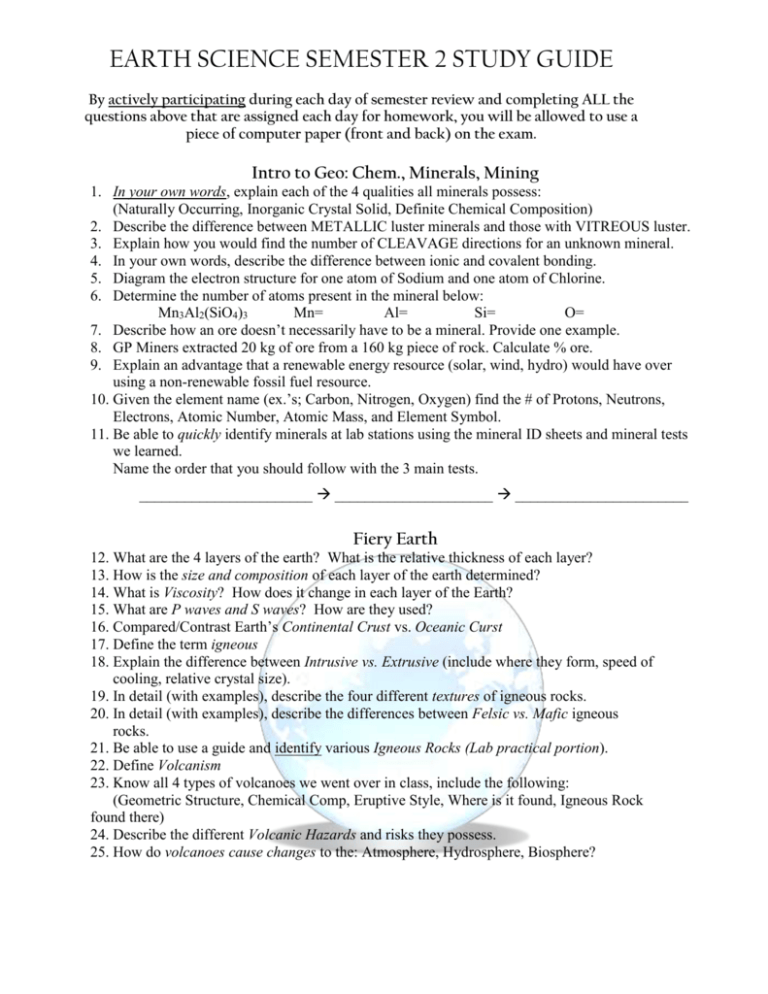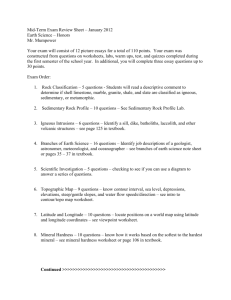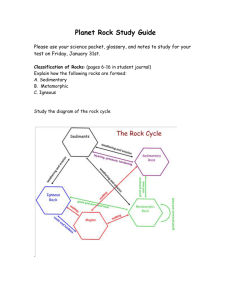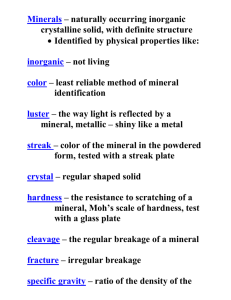Earth Science Final Exam Review
advertisement

EARTH SCIENCE SEMESTER 2 STUDY GUIDE By actively participating during each day of semester review and completing ALL the questions above that are assigned each day for homework, you will be allowed to use a piece of computer paper (front and back) on the exam. Intro to Geo: Chem., Minerals, Mining 1. In your own words, explain each of the 4 qualities all minerals possess: (Naturally Occurring, Inorganic Crystal Solid, Definite Chemical Composition) 2. Describe the difference between METALLIC luster minerals and those with VITREOUS luster. 3. Explain how you would find the number of CLEAVAGE directions for an unknown mineral. 4. In your own words, describe the difference between ionic and covalent bonding. 5. Diagram the electron structure for one atom of Sodium and one atom of Chlorine. 6. Determine the number of atoms present in the mineral below: Mn3Al2(SiO4)3 Mn= Al= Si= O= 7. Describe how an ore doesn’t necessarily have to be a mineral. Provide one example. 8. GP Miners extracted 20 kg of ore from a 160 kg piece of rock. Calculate % ore. 9. Explain an advantage that a renewable energy resource (solar, wind, hydro) would have over using a non-renewable fossil fuel resource. 10. Given the element name (ex.’s; Carbon, Nitrogen, Oxygen) find the # of Protons, Neutrons, Electrons, Atomic Number, Atomic Mass, and Element Symbol. 11. Be able to quickly identify minerals at lab stations using the mineral ID sheets and mineral tests we learned. Name the order that you should follow with the 3 main tests. _______________________ _____________________ _______________________ Fiery Earth 12. What are the 4 layers of the earth? What is the relative thickness of each layer? 13. How is the size and composition of each layer of the earth determined? 14. What is Viscosity? How does it change in each layer of the Earth? 15. What are P waves and S waves? How are they used? 16. Compared/Contrast Earth’s Continental Crust vs. Oceanic Curst 17. Define the term igneous 18. Explain the difference between Intrusive vs. Extrusive (include where they form, speed of cooling, relative crystal size). 19. In detail (with examples), describe the four different textures of igneous rocks. 20. In detail (with examples), describe the differences between Felsic vs. Mafic igneous rocks. 21. Be able to use a guide and identify various Igneous Rocks (Lab practical portion). 22. Define Volcanism 23. Know all 4 types of volcanoes we went over in class, include the following: (Geometric Structure, Chemical Comp, Eruptive Style, Where is it found, Igneous Rock found there) 24. Describe the different Volcanic Hazards and risks they possess. 25. How do volcanoes cause changes to the: Atmosphere, Hydrosphere, Biosphere? EARTH SCIENCE SEMESTER 2 STUDY GUIDE Erosive Forces 26. Describe the characteristic differences between the following Glacial Features: Glacial Zones: Zone of Accumulation vs. Zone of Ablation/Wastage Glacial Movement: Basal Slip vs. Internal Plastic Flow, Glacial Movement: Advance vs. Retreat Types of Glaciers: Alpine vs. Continental Glacial Erosion: Plucking vs. Abrasion) 27. Know the following mountain glacier landforms and be able to describe how each formed. (Horn, Cirque, Arête, Hanging valley, U-shaped valley, Erratics, Striations, Outwash Plain/Sediment, Lateral Moraines) 28. Know the following continental glacier landforms and be able to describe how each formed. (Erratic, End Moraine, Drumlin, Esker, Kame, Kettle Lake) 29. Describe how you would VISIBLY distinguish between glacial outwash and till. 30. Describe how to find the youngest oldest moraines on a glacial map. 31. Explain how glaciers played a major role in the formation of the great lakes and the state of MI. 32. Know the characteristics of Sand, Silt, and Clay. (Sediment size, Cohesiveness, Carried by, etc.) 33. Describe Mass Movements and know which are most common in MI. 34. Describe what kind of information should go into a geologic study before construction takes place. Fluid Forces 35. Describe the characteristic differences between the following (erosional or depositional): (Headwaters, Floodplain, Meander, Watershed, Cutbank, Delta, Tributary, Oxbow, Divide, Point Bar) 36. Know calculations of : (give examples) Gradient/Slope Discharge 37. Know how sediment is carried by streams, and sediment is eroded by streams. Bedload, Suspended Load, Dissolved Load Headward, Downcutting, Meandering 38. Know features of Young Streams/Rivers, Mature Rivers, Older Rivers 39. Know the Great Lakes watershed and be able to trace water flowing from any where in the great lakes. 40. Describe flooding and differences in Urban vs. Rural areas. 41. Describe the three ways to prevent flooding, give examples (or drawings). 42. Know waves, how they form and how they become breakers. 43. Know what is Beach Erosion and how can it be prevented. Sedimentary Rocks, Weathering & Groundwater 44. Know Sedimentary Rock formation and composition (Clastic, Bioclastic, Chemical) 45. Know Sedimentary Rock Features: Strata, Mud Cracks, Ripple Marks, Fossils 46. Be able to use the above characteristics and features to identify Sed. Rocks. 47. What is weathering? (Know the difference between Mechanical and Chemical) Give examples of both. 48. What is Corrosion? Do we have this problem a lot in MI? How can you fix it? 49. What are the 3 main factors that influence how fast a rock surface weathers? EARTH SCIENCE SEMESTER 2 STUDY GUIDE 50. What mineral is least affected by weathering? Mineral most affected? 51. Know the pH scale (0-10) Which side is acidic, which is basic? 52. How does weather affect Igneous + Metamorphic Rock? Sed. Rock? 53. Know Regolith vs. Bedrock 54. What are the four components of soil? 55. If the parent material of soil is rich in Quartz what type of soil is it? 56. If the parent material is rich in Feldspar, what type of soil is it? 57. Know a soil profile (A, B, C layers) 58. How does climate affect soil profiles? (Temperate vs. Tropical, Desert, Arctic) 59. Know porosity vs. permeability 60. Be able to describe the different zones of groundwater. (3 of them) 61. What is an aquifer? Aquitard? 62. Know how an Ordinary Well works vs. an Artesian well. Dynamic Earth 63. Know what Wegner’s “continental drift theory” was and the evidence he had for it. 64. What theory replace wegner’s? Describe plate tectonics. 65. Know Divergent, Convergent, and Transform plate boundaries. (use the words tension, compression and shearing to describe) 66. What is the difference between oceanic and continental lithosphere (crust)? 67. Know the lithosphere interactions at each type of boundary (ocean-continental; continental-continental; ocean-ocean). 68. What is Deformation? 69. Explain Stress vs. Strain 70. Know folding and faulting and the landforms (Mountains) associated with each. 71. Know how meta rx’s are formed, explain Foliated vs. Non-Foliated 72. What is a parent material? 73. Be able to identify Metamorphic Rocks. 74. Know why and how earthquakes form. 75. What is the difference between the Focus and the Epicenter of a quake? 76. Explain P-waves, S-waves, and Surface waves 77. What is the Richter Scale? 78. What is a tsunami? Earth’s Geologic Time This is our most recent unit and our review for the unit test is the best review (and most fresh on our minds) for the final exam. Below is the overview of what you should know. 79. Know Relative Age Dating 80. Be able to look at a cross section and identify the order of events that took place. 81. Know Absolute Age Dating 82. Know what a half-life is. 83. Be able to use a half-life chart and radiometric chart to determine a rock absolute age. 84. Know what the daughter/parent ratio means, and how to calculate. 85. Know the basic geological history of the Precambrian, Paleozoic, Mesozoic and Cenozioc Eras.








